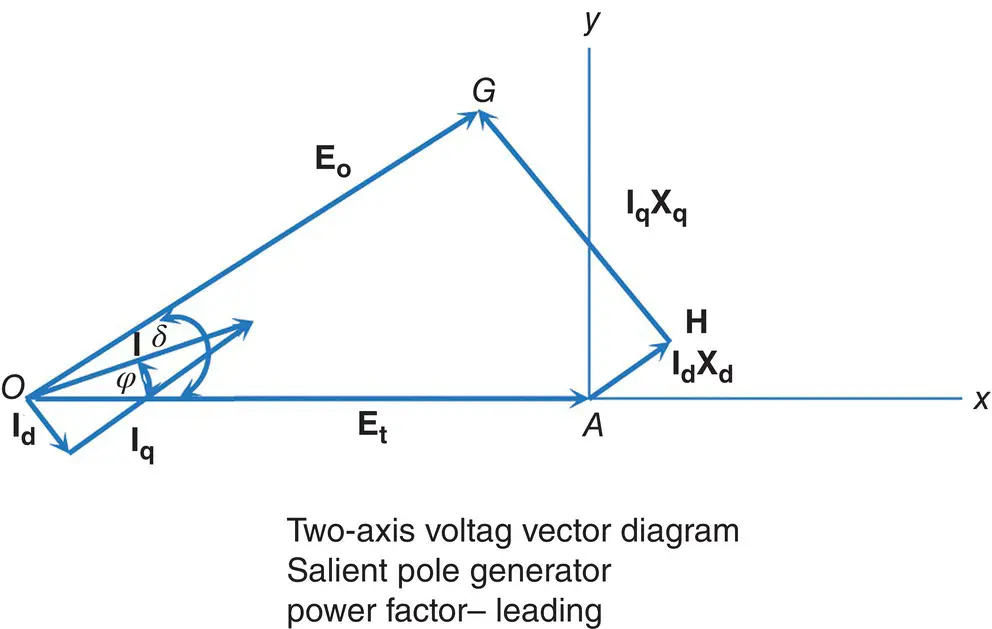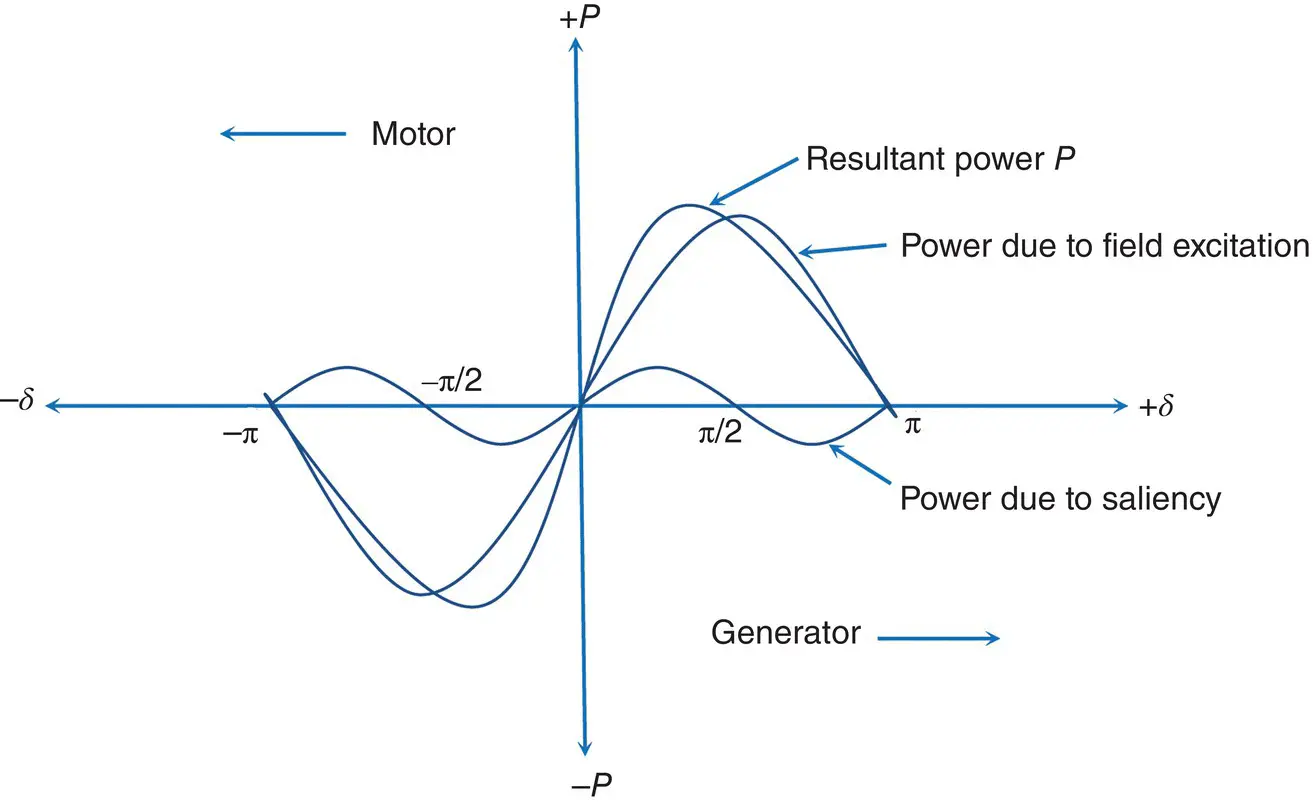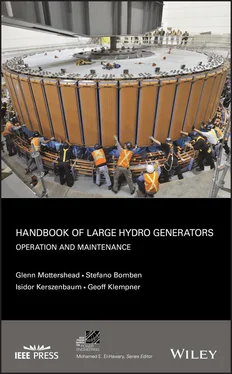
Figure 1.7-4Vector diagram of generator with a leading power factor.
Referring to Figure 1.7-4, there are some key differences worth noting while operating at a leading power factor. The armature current Iis now leading the terminal voltage E tby the angle φ . The quadrature axis components I qand I q X qare now larger in magnitude than when the machine was lagging. The takeaway from this diagram is that the terminal voltage is higher than the internal generated voltage. This also makes sense as the generator is now absorbing reactive power so the terminal voltage must be higher to push the power back into the machine.
It is important to recognize that as soon as the internal generated voltage is higher or lower than the terminal voltage, even by the smallest amount, reactive power will be supplied or absorbed by the machine accordingly.
1.7.3 System Support: Reactive Power
For all intents and purposes, during reactive power support operation, there is no water flowing through the turbine, thus no MW are being supplied to the system. However, by adjusting the excitation higher (over excitation), the machine can deliver reactive power and by decreasing the excitation (under excited), the machine can absorb reactive power. This mode of operation for a conventional generator (that normally supplies MW as well) is only during times where there may be an abnormal system condition and the generator will need to provide this reactive support or there is system emergency and extreme reactive support is required.
On one end of extreme operation, there is almost no current supplied to the DC field winding of the rotor and large amounts of reactive power (MVARS) are being absorbed by the generator. The capability curve, which is discussed later in the book, will have limits set as to how many MVARS the generator may absorb on a continuous basis without damaging effects. This mode of operation is not far from operating with a loss of excitation. Protections are put in place to prevent migration into this potentially damaging area of operation. Depending on the design of the generator and excitation system, rotating or static, the minimum excitation value can approach 10 A or less before the excitation system bottoms out and/or protections operate.
On the other end of extreme operation, the generator will need to supply large amounts of reactive power (MVARS) to the system, again, for abnormal system events or emergencies. Again, the capability curve from the manufacturer will outline what the maximum capability is and over excitation limits can be put in place to protect the generator from damaging effects from rotor overheating.

Figure 1.7-5Steady‐state power angle characteristic of a salient pole synchronous machine (with negligible armature resistance).
It is now appropriate to expand on the effects of “saliency” on generator operation. Power developed in a salient pole machine can be written as Equation (1.1)[1]:
(1.1) 
The term on the left‐hand side of the “+” sign is the power developed due to the field excitation. The term on the right‐hand side of the “+” sign is the power developed due to saliency. A graphic representation of the resultant power is shown in Figure 1.7-5[1].
Even if no current is supplied to the DC field winding, there is a torque generated known as reluctance torque, due to the saliency effect. It is this torque which keeps the rotor in synchronism with the system, and prevents the machine from slipping poles.
The electric machine can be specifically designed to operate as a pump motor so it performs useful physical work. In this particular arrangement, the motor pumps water through the penstock for irrigation or as storage when power is abundant to be used later to generate when power is in short supply. Synchronous pump motors are designed to operate at a fixed speed without any slip between the armature frequency and the fields rotating frequency. To bring the motor to synchronous speed, it must be accelerated by a method consistent with its design. A separate induction starting motor dedicated to accelerating the synchronous rotor is a common starting method. Other methods incorporating variable frequency sources or across‐the‐line inductive starting by the rotor damper windings are also used. In the situation, where across‐the‐line starting is used, the damper windings will get very hot quickly and the machine must be synchronized within the recommended time by the manufacturer. Failed synchronization attempts must allow for cooling of the damper circuit before an attempt to start the machine is made again. This cooling off period will also be specified by the manufacturer. Failure to follow these set procedures can result in overheated and even melted damper assemblies which in turn will affect starting performance and may require repair depending on the severity. If a known excursion from these procedures has occurred, it is highly recommended that a visual inspection of the damper assembly by a knowledgeable person be performed.
When dealing with three‐phase balanced circuits, electrical engineers use the one‐line or single‐line representation. This simplification is allowed because in three‐phase balanced circuits, all currents and voltages, as well as circuit elements are symmetrical. Thus, by “showing” only one phase, it is possible to represent the three‐phase system, as long as care is taken in using the proper factors. For instance, the three‐phase balanced system of Figure 1.4-1or Figure 1.4-2can be represented as shown in Figure 1.7-5. Hereinafter, when describing a three‐phase generator by an electrical diagram, the one‐line method will be used.
The most convenient way to determine the performance characteristics of synchronous machines is by means of equivalent circuits. These equivalent circuits can become very elaborate when saturation, armature reaction, harmonic reactance, and other nonlinear effects are introduced. However, the simplified circuit in Figure 1.7-6is conducive to obtaining the basic performance characteristics of the machine under steady‐state conditions.
In Figure 1.7-7, the reactance X a, represents the magnetizing or demagnetizing effect of the stator windings on the rotor. It is also called the magnetizing reactance or armature reaction reactance . R arepresents the effective resistance of the stator. The reactance X lrepresents the stator leakage reactance. The sum of X aand X lis used to represent the total reactance of the machine and is called the synchronous reactance ( X s) . Z s i s the synchronous impedance of the machine. The internal generated voltage is represented by E o, the airgap voltage by E r, and finally the terminal voltage of the machine by E t. It is important to remember that the equivalent circuit described in Figure 1.7-7represents the machine only under steady‐state conditions.
Читать дальше














